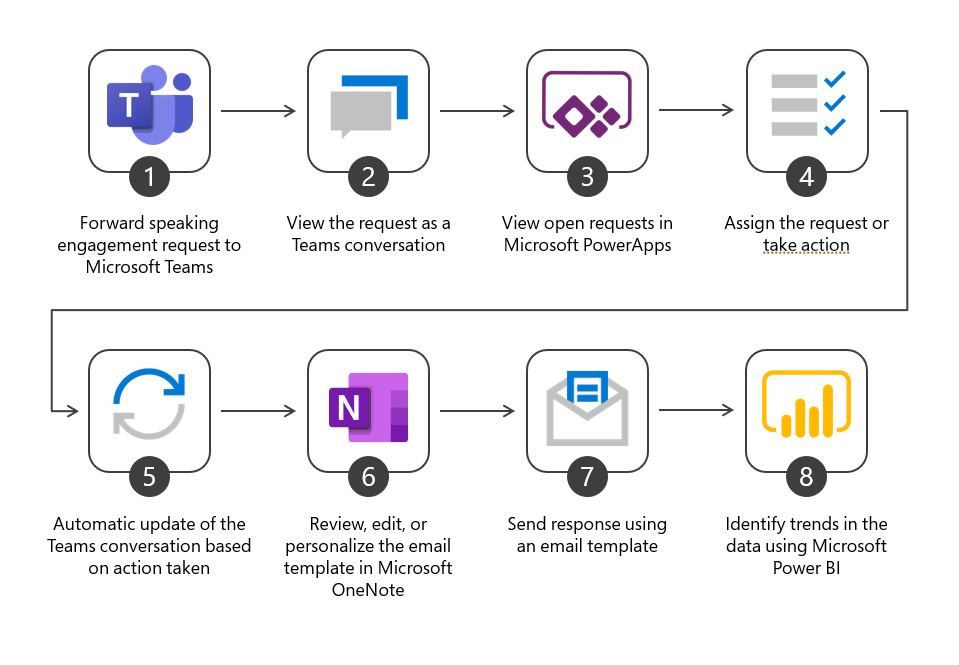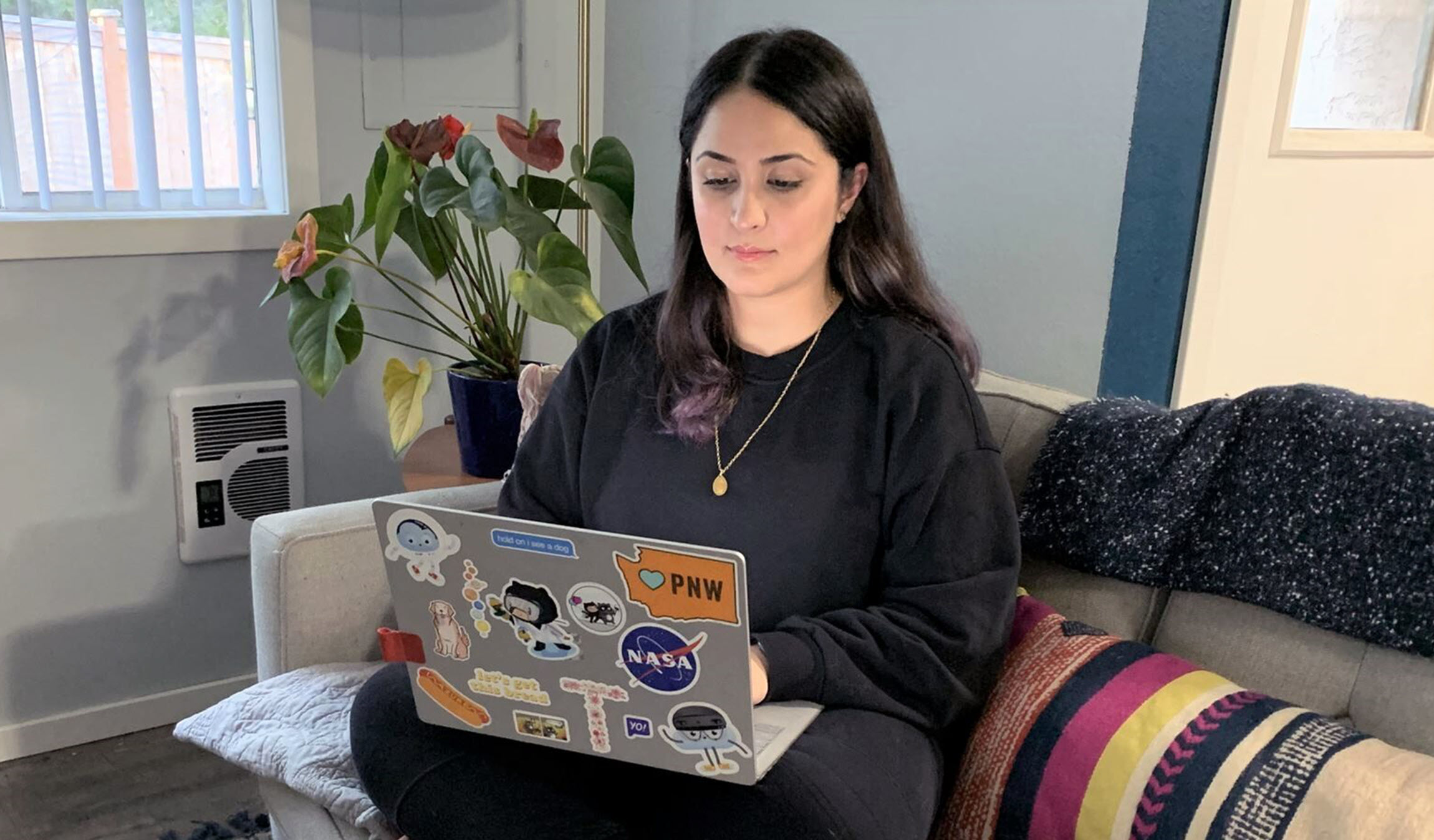This content has been archived, and while it was correct at time of publication, it may no longer be accurate or reflect the current situation at Microsoft.
What do customers and internal teams want to learn when it comes to Cloud + AI at Microsoft?
In a word, everything.
“Cloud + AI at Microsoft encompasses everything from cloud infrastructure and developer tools to business applications and Microsoft HoloLens,” says Tahira Al-Faham, a business manager in Microsoft Cloud + AI who manages speaking engagement requests in this division of the company. “Leaders in Cloud + AI highlight how customers are innovating and achieving their goals with our products and services, and this is an important aspect of how we can share our story.”
Al-Faham says that Cloud + AI at Microsoft delivers products and services such as Microsoft Azure, Microsoft Power Platform, and GitHub, which are used by 95 percent of the Fortune 500. Leaders in Microsoft Cloud + AI team receive dozens of requests to speak about how Microsoft uses its applications in every part of the business. These speaking engagements range from coffee chats with summer interns to keynotes at national conferences.
Al-Faham manages speaking requests for the entire Microsoft Cloud + AI division in partnership with the division’s chief of staff and her team.
Before, tracking and categorizing requests for speaking engagements was a largely manual process that lived in email and Microsoft Excel. This created a much higher risk for error, and the team had less time and data to identify trends in speaking engagement requests. Al-Faham and her team responded to every request within 24 hours, but they didn’t have a single location to collect and synthesize the rich data they were getting on the requests they received.
“Our team is really agile, but we hadn’t set up a dashboard to capture trends or break down speaking engagements by key categories such as industry, type, and audience,” Al-Faham says. “Having all the data in one place would help us understand our current focus and identify future topics we want to cover.”
Her team needed a tool that would get them out of email and into a connected, collaborative process that could be used to respond to, track, and identify trends in speaking engagement requests.
A team at Microsoft was ready to step in and help: Productivity Studio, a partnership between Microsoft and Avanade, which is a joint venture between Accenture and Microsoft. Aptly named, this team in Microsoft Digital empowers productivity at every level of the organization.
“When your process is already streamlined, you don’t always pause to think about how you can make it even more efficient,” Al-Faham says. “I can rely on the experts in Productivity Studio because they know how to get the most out of Microsoft productivity tools.”
With the help of Productivity Studio, Al-Faham’s team and their partner teams in public relations and analyst relations now have access to a centralized tool for managing speaking requests from reception to delegation. Originally created for the Office of the CEO at Microsoft, this tool has now been adapted for senior leaders across the company.
You never have to hit copy and paste because the tool manages the experience for you. We took the process out of email and created a connected, intelligent experience that provides more insights with less effort.
– Gregory Kriegler, client executive at Avanade and Avanade lead in Productivity Studio
The tool harnesses the power of Microsoft 365 stack and the Microsoft Power Platform to create a centralized dashboard of requests. Instead of looking for Microsoft Excel files or digging for the latest email template, Al-Faham and her partner teams are in lockstep about upcoming engagements. They can even reduce the amount of time and frequency of meetings because they can seamlessly collaborate and automatically follow up with requesters.
“You never have to hit copy and paste because the tool manages the experience for you,” says Gregory Kriegler, a client executive at Avanade and the Avanade lead in Productivity Studio. “We took the process out of email and created a connected, intelligent experience that provides more insights with less effort. We love to empower employees like Tahira to achieve more.”
[Find out how Microsoft builds connected solutions with Microsoft Power Automate.]
Accelerating time to value using the Microsoft Power Platform
Al-Faham and her team manage the influx of speaking engagements by harnessing the power of the Microsoft 365 stack, including Microsoft Teams, Microsoft Outlook, and Microsoft SharePoint, to track and categorize speaking engagements. Microsoft Power Automate is the glue that seamlessly connects all these applications into a streamlined business process.
The best part? It required very little code to develop.
“The Microsoft Power Platform offers a great deal of low-code flexibility, and we’re able to create high-impact, compliant solutions in weeks that used to take months or years to develop,” Kriegler says.

Al-Faham and her team in Cloud + AI have a single dashboard for viewing open speaking engagement requests, which is powered by Microsoft Power Apps. For Al-Faham, the workflow begins after she receives an email with a speaking engagement request, which she can view as a Microsoft Teams conversation. Microsoft Power Automate is used to automatically identify the subject, requestor, and requested date from the email. All this information is posted in an adaptive card in Microsoft Teams and logged in Microsoft Lists. Here, Al-Faham and her team can assign speaking engagement requests like tickets or cases to members of her team and her partner team.
This new fiscal year, we have all the data tracked in the same place, and in real time. If someone wants to see a report for all upcoming speaking engagements, I can send it in minutes.
– Tahira Al-Faham, business manager in Microsoft Cloud + AI
This new way of work was simpler, faster, and more efficient. “We now have a single dashboard where we can check the status of requests,” Al-Faham says. “We wanted to put it all in one place with shared access and create alignment across our partner teams and us.”
From there, Al-Faham’s team can either accept or politely decline a request using email templates, which can be edited and personalized in Microsoft OneNote. If the team accepts a speaking engagement request, Al-Faham can categorize the speaking engagement type and requestor.
“Connecting all of these applications helps us manage our workflow,” Al-Faham says.
Using Microsoft Power BI, Al-Faham can use the speaking engagements tool to identify trends in requests and inform future decision-making. Instead of tracking this data manually, Al-Faham has this rich data at her fingertips.
“This new fiscal year, we have all the data tracked in the same place, and in real time,” Al-Faham says. “If someone wants to see a report for all upcoming speaking engagements, I can send it in minutes.”
The Productivity Studio team knows that a single workflow for managing speaking engagements isn’t a one-size-fits-all solution. For example, Al-Faham and her team wanted to be able to backdate a request or assign tasks to members of her partner team.
Because the Microsoft Power Platform technology is so flexible, the Productivity Studio team is adding this feature, which should be available to Al-Faham and her team in a matter of days.
“Building the application using Power Apps gave us the agility to build quickly,” Kriegler says. “We can also make adjustments for leaders across lines of business so everyone gets a solution that works with their unique processes.”
Identifying core business requirements for your organization
Kriegler says that leaders and employees like Al-Faham have been really receptive to the tool.
“Most of the employees we’ve worked with say, ‘I knew this was a problem, but I didn’t know how to solve it, and you’ve already solved it better than I would’ve imagined,’” Kriegler says. “I’ve heard that more than once, and it’s made our team really proud.”
The Productivity Studio team has demonstrated the versatility of the Power Platform, and they’ve even adapted the solution to work for an IT support desk ticketing system. He encourages other teams and enterprises to use the Microsoft Power Platform to experiment.
“If you want to test a hypothesis and prove something, the Power Platform is the perfect toolset to do that,” Kriegler says. “You can capture feedback on clickthrough demos, build solutions rapidly, and make your people, teams, and enterprises more productive.”
David Johnson, a principal program manager in Microsoft Digital and architect for internal Microsoft 365 business solutions, encourages other enterprises to use the Microsoft Power Platform to build automated workflows for their business, but only after understanding your scale and identifying key business requirements.
“Understand the complexity of the workflow and the apps you’re integrating,” Johnson says. “Can you connect a data change in a SharePoint list to an email or Teams notification? Use Power Automate when the simplest workflow would be sufficient. In some cases, the solution might require a more complex data storage system or additional components, but SharePoint fulfills the needs of a simple solution.
Other companies and enterprises can also use a similar workflow model or adapt it to their needs: Use Microsoft SharePoint for data storage, connect applications using Microsoft Power Automate, trigger notifications using Microsoft Outlook or Microsoft Teams, and identify data trends using Microsoft Power BI.
“This is something that customers can emulate to accelerate time to value,” Johnson says. “You can predefine where a workflow should go, whether it’s to a team, individual, or group.”
The Microsoft Power Platform is one tool for accelerating time to value, but that doesn’t diminish the importance of having good engineering practices.
“It’s still all about the user experience,” Kriegler says. “The Power Platform allows us to experiment and design solutions with more input and in better partnership with our users.”
With this efficient process for managing speaking engagements, Al-Faham is ready for this fiscal year, which may offer even more opportunities for leaders to tell the story of Cloud + AI at Microsoft.
“This year, we’re receiving more requests for virtual engagements than ever, which gives us even more opportunities to tell our story,” Al-Faham says. “This was a great time to bring in this tool, and I’m excited to keep using it.”
Find out how Microsoft builds connected solutions with Microsoft Power Automate.








